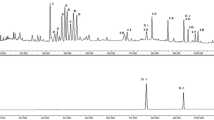Abstract
Pathological angiogenesis of liver which includes liver sinusoidal capillarization due to lose of fenestraes of liver sinusoidal endothelial cells (LSECs) and formation of new vascular, is a crucial mechanism responsible for origination and development of liver fifibrosis and closely involves in the development of cirrhosis and hepatic cancer. Anti-neovascularization medicine such as sorafenib can decrease portosystemic shunts, improve splanchnic hyperdynamic circulation, lower portal hypertension, while it can not be applied in clinic due to its serious toxic and side reactions. Chinese herbal formula can effectively inhibit pathological angiogenesis of liver, improve microcirculation of liver, and decrease the probability of gastrointestinal hemorrhage in cirrhotic patients. Different Chinese herbal formula are of different characteristics on inhibiting pathological angiogenesis in liver fifibrosis, which partly explains synergistic effect of different compatibility of Chinese materia medica and opens up good vista for Chinese medicine against liver fifibrosis through inhibiting angiogenesis.
Similar content being viewed by others
References
Ding BS, Cao ZW, Lis R, Nolan DJ, Guo PP, Simons M, et al. Divergent angiocrine signals from vascular niche balance liver regeneration and fibrosis. Nature 2014;505:97–102.
Lee JS, Semela D, Iredale J, Shah VH. Sinusoidal remodeling and angiogenesis: a new function for the liverspecific pericyte? Hepatology 2007;45:817–825.
Straub AC, Stolz DB, Ross MA, Hernández-Zavala A, Soucy NV, Klei LR, et al. Arsenic stimulates sinusoidal endothelial cell capillarization and vessel remodeling in mouse liver. Hepatology 2007;45:205–212.
Mehta G, Gustot T, Mookerjee RP, Garcia-Pagan JC, Fallon MB, Shah VH, et al. Inflammation and portal hypertension— the undiscovered country. J Hepatol 2014;61:155–163.
Thabut D, Shah V. Intrahepatic angiogenesis and sinusoidal remodeling in chronic liver disease: new targets for the treatment of portal hypertension? J Hepatol 2010;53:976–980.
Lin HC, Huang YT, Yang YY, Lee PC, Hwang LH, Lee WP, et al. Beneficial effects of dual vascular endothelial growth factor receptor/fibroblast growth factor receptor inhibitor brivanib alaninate in cirrhotic portal hypertensive rats. J Gastroenterol Hepatol 2014;29:1073–1082.
Mejias M, Garcia-Pras E, Tiani C, Miquel R, Bosch J, Fernandez M. Beneficial effects of sorafenib on splanchnic, intrahepatic, and portocollateral circulations in portal hypertensive and cirrhotic rats. Hepatology 2009;49:1245–1256.
Tugues S, Fernandez-Varo G, Muñoz-Luque J, Ros J, Arroyo V, Rodés J, et al. Antiangiogenic treatment with Sunitinib ameliorates inflammatory infiltrate, fibrosis, and portal pressure in cirrhotic rats. Hepatology 2007;46:1919–1926.
Gu J, Zhang Q, Xue D, Cai H, Xu L. A randomized controlled study of Fuzheng Huayu Capsule for prevention of esophageal variceal bleeding in patients with liver cirrhosis. Evid Based Complement Alternat Med 2013;2013:697–715.
Lu X, Liu P, Liu C. Effect of Fuzheng Huayu Recipe on hepatic sinusoid capillarization in the rat of dimethyl nitrosamine-induced hepatic fibrosis. J Tradit Chin Med (Chin) 2003;44:136–139
Lyu J, Tan Y, Zhao ZM, Huang K, Shen L, Tao YY, et al. Fuzheng Huayu Formula exerted anti-liver fibrosis through inhibiting angiogenesis. World Chin Med (Chin) 2015;10:186–191.
Tang ZP, Liu P, Wang XB. Effect of Cordyceps mycelia extract on hepatic sinusoidal endoth-elial cells permeability in dimethylnitrosamine-induced liver fibrosis in rats. Chin J New Drugs Clin Remed (Chin) 2006;25:713–717.
Wang XB, Liu P, Tang ZP. Intervening and therapeutic effect of Cordyceps mycelia extract on liver cirrhosis induced by dimethylnitrosamine in rats. Chin J Integr Tradit West Med (Chin) 2008;28:617–622.
Wang XB, Liu P, Tang ZP. Effect of Cordyceps mycelia extract on injury and phenotype shift of liver sinusoidal endothelial cells in rats with dimethylnitrosamine-induced liver cirrhosis. J Beijing Univ Tradit Chin Med (Chin) 2008;31:448–451.
Du JX, Sun MY, Du GL, Li FH, Liu C, Mu YP, et al. Ingredients of Huangqi Decoction slow biliary fibrosis progression by inhibiting the activation of the transforming growth factor-beta signaling pathway. BMC Complement Alternat Med 2012;12:1–11.
Liu C, Wang GQ, Chen GF, Mu YP, Zhang LJ, Hu XD, et al. Huangqi Decoction inhibits apoptosis and fibrosis, but promotes Kupffer cell activation in dimethylnitrosamine-induced rat liver fibrosis. BMC Complement Alternat Med 2012;12:1–8.
Du GL, Liu P, Wang L, Tan SZ, Long AH, Mu YP, et al. Expression of matrix metalloproteinase 9/13 (MMP-9/13) and tissue inhibitor of metalloproteinase 1/2 (TIMP-1/2) in liver fibrosis induced by porcine serum and Xiayuxue Decoction on it. Chin J Exper Tradit Med Formu (Chin) 2009;15:48–51.
Du JX, Liu P, Sun MY, Tao Q, Zhang LJ, Chen GF, et al. Chinese herbal medicine Xiayuxue Decoction inhibits liver angiogenesis in rats with carbon tetrachloride-induced liver fibrosis. J Chin Integr Med (Chin) 2011;9:878–887.
Zhang LJ, Sun MY, Ning BB, Zhang WM, Chen GF, Mu YP, et al. Xiayuxue Decoction attenuates hepatic stellate cell activation and sinusoidal endothelium defenestration in CCl4-induced fibrotic liver of mice. Chin J Integr Med 2014;20:516–523.
Zhou YN, Sun MY, Mu YP, Yang T, Ning BB, Ren S, et al. Xuefuzhuyu decoction inhibition of angiogenesis attenuates liver fibrosis induced by CCl4 in mice. J Ethnopharmacol 2014;153:659–666.
Mu YP, Liu P, Wang L, Liu C, Wang GQ, Du JX, et al. Hepatic gene expression analysis of carbon tetrachlorideinduced rat cirrhosis identifies distinct effects of Yiguanjian Decoction. Modern Tradit Chin Med Mater Med—World Sci Technol (Chin) 2007;9:43–54.
Zhou YN, Mu YP, Fu WW, Ning BB, Du GL, Chen JM, et al. Yiguanjian decoction and its ingredients inhibit angiogenesis in carbon tetrachloride-induced cirrhosis mice. BMC Complement Alternat Med 2015;15:1–9.
Hano H, Takasaki S, Kobayashi H, Koyama T, Lu T, Nagatsuma K. In the non-cirrhotic stage of nonalcoholic steatohepatitis, angioarchitecture of portal veins and lobular architecture are maintained. Virchows Arch 2013;462:533–540.
Author information
Authors and Affiliations
Corresponding author
Rights and permissions
About this article
Cite this article
Liu, P. Inhibition of pathological angiogenesis of Chinese medicine against liver fibrosis. Chin. J. Integr. Med. 22, 569–572 (2016). https://doi.org/10.1007/s11655-016-2468-3
Received:
Published:
Issue Date:
DOI: https://doi.org/10.1007/s11655-016-2468-3




